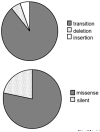p53 tumor suppressor gene mutations in fibroblast-like synoviocytes from erosion synovium and non-erosion synovium in rheumatoid arthritis
- PMID: 15642132
- PMCID: PMC1064878
- DOI: 10.1186/ar1448
p53 tumor suppressor gene mutations in fibroblast-like synoviocytes from erosion synovium and non-erosion synovium in rheumatoid arthritis
Abstract
Abnormalities in the p53 tumor suppressor gene have been detected in rheumatoid arthritis (RA) and could contribute to the pathogenesis of chronic disease. To determine whether synoviocytes from invasive synovium in RA have an increased number of mutations compared with non-erosion synoviocytes, p53 cDNA subclones from fibroblast-like synoviocytes (FLS) derived from erosion and non-erosion sites of the same synovium were examined in patients requiring total joint replacement. Ten erosion FLS lines and nine non-erosion FLS lines were established from nine patients with RA. Exons 5-10 from 209 p53 subclones were sequenced (114 from erosion FLS, 95 from non-erosion FLS). Sixty percent of RA FLS cell lines and 8.6% of the p53 subclones isolated from FLS contained p53 mutations. No significant differences were observed between the erosion and non-erosion FLS with regard to the frequency or type of p53 mutation. The majority of the mutations were missense transition mutations, which are characteristic of oxidative damage. In addition, paired intact RA synovium and cultured FLS from the same joints were evaluated for p53 mutations. Matched synovium and cultured synoviocytes contained p53 mutations, although there was no overlap in the specific mutations identified in the paired samples. Clusters of p53 mutations in subclones were detected in some FLS, including one in codon 249, which is a well-recognized 'hot spot' associated with cancer. Our data are consistent with the hypothesis that p53 mutations are randomly induced by genotoxic exposure in small numbers of RA synoviocytes localized to erosion and non-erosion regions of RA synovium. The determining factor for invasiveness might be proximity to bone or cartilage rather than the presence of a p53 mutation.
Figures
Similar articles
-
Invasiveness of synovial fibroblasts is regulated by p53 in the SCID mouse in vivo model of cartilage invasion.Arthritis Rheum. 2001 Mar;44(3):676-81. doi: 10.1002/1529-0131(200103)44:3<676::AID-ANR117>3.0.CO;2-6. Arthritis Rheum. 2001. PMID: 11263783
-
CD147 overexpression on synoviocytes in rheumatoid arthritis enhances matrix metalloproteinase production and invasiveness of synoviocytes.Arthritis Res Ther. 2006;8(2):R44. doi: 10.1186/ar1899. Epub 2006 Feb 8. Arthritis Res Ther. 2006. PMID: 16507143 Free PMC article.
-
Invasiveness of fibroblast-like synoviocytes is an individual patient characteristic associated with the rate of joint destruction in patients with rheumatoid arthritis.Arthritis Rheum. 2005 Jul;52(7):1999-2002. doi: 10.1002/art.21118. Arthritis Rheum. 2005. PMID: 15986342
-
Fibroblast-like synoviocytes in inflammatory arthritis pathology: the emerging role of cadherin-11.Immunol Rev. 2010 Jan;233(1):256-66. doi: 10.1111/j.0105-2896.2009.00854.x. Immunol Rev. 2010. PMID: 20193004 Review.
-
Wnt signalling in rheumatoid arthritis.Rheumatology (Oxford). 2005 Jun;44(6):708-13. doi: 10.1093/rheumatology/keh553. Epub 2005 Feb 10. Rheumatology (Oxford). 2005. PMID: 15705634 Review.
Cited by
-
Altered expression of TPP1 in fibroblast-like synovial cells might be involved in the pathogenesis of rheumatoid arthritis.Rheumatol Int. 2012 Aug;32(8):2503-10. doi: 10.1007/s00296-011-1992-x. Epub 2011 Jul 16. Rheumatol Int. 2012. PMID: 21833529
-
TP53 mutations coincide with the ectopic expression of activation-induced cytidine deaminase in the fibroblast-like synoviocytes derived from a fraction of patients with rheumatoid arthritis.Clin Exp Immunol. 2010 Jul 1;161(1):71-80. doi: 10.1111/j.1365-2249.2010.04163.x. Epub 2010 May 10. Clin Exp Immunol. 2010. PMID: 20491788 Free PMC article.
-
Corticosteroid Treatment-Resistance in Myasthenia Gravis.Front Neurol. 2022 Apr 25;13:886625. doi: 10.3389/fneur.2022.886625. eCollection 2022. Front Neurol. 2022. PMID: 35547366 Free PMC article. Review.
-
Overexpression of p53 delivered using recombinant NDV induces apoptosis in glioma cells by regulating the apoptotic signaling pathway.Exp Ther Med. 2018 May;15(5):4522-4530. doi: 10.3892/etm.2018.5935. Epub 2018 Mar 8. Exp Ther Med. 2018. PMID: 29731836 Free PMC article.
-
Perception of self: distinguishing autoimmunity from autoinflammation.Nat Rev Rheumatol. 2015 Aug;11(8):483-92. doi: 10.1038/nrrheum.2015.60. Epub 2015 May 12. Nat Rev Rheumatol. 2015. PMID: 25963881 Review.
References
-
- Feldmann M, Maini RN, Bondeson J, Taylor P, Foxwell BM, Brennan FM. Cytokine blockade in rheumatoid arthritis. Adv Exp Med Biol. 2001;490:119–127. - PubMed
-
- Joosten LA, Helsen MM, Saxne T, van De Loo FA, Heinegard D, van Den Berg WB. IL-1 alpha beta blockade prevents cartilage and bone destruction in murine type II collagen-induced arthritis, whereas TNF-alpha blockade only ameliorates joint inflammation. J Immunol. 1999;163:5049–5055. - PubMed
-
- Firestein GS. Invasive fibroblast-like synoviocytes in rheumatoid arthritis. Passive responders or transformed aggressors? Arthritis Rheum. 1996;39:1781–1790. - PubMed
Publication types
MeSH terms
Substances
LinkOut - more resources
Full Text Sources
Other Literature Sources
Medical
Research Materials
Miscellaneous


